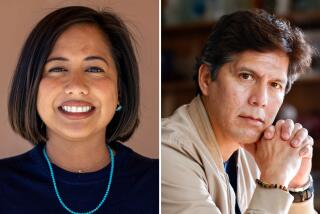Districting Strategy : Alatorre Deals Leave Woo as the Only Loser
- Share via
Councilman Richard Alatorre won the first round of his controversial attempt to redraw the district lines of the Los Angeles City Council last week by aiming his political scalpel at one district--Councilman Michael Woo’s--while making sure that the surgery remained painless for the other 13.
Under the Alatorre plan, political boundary lines would be redrawn so that Woo, the council’s only Asian, would be moved eastward, out of Hollywood, and--much against his will--into a two-thirds Latino district. The 10-5 preliminary vote Tuesday approving the plan was in response to a federal lawsuit filed last year charging that present council district boundaries diluted the political power of the city’s 27.5% Latino population.
The council is scheduled to vote on the district lines as realigned by Alatorre again Tuesday. If passed, the plan would go to Mayor Tom Bradley for his approval or veto. Council President Pat Russell has said that a Bradley veto “is a good possibility.” If approved by the council and Bradley, the plan would go before a federal court for resolution of the lawsuit.
Alatorre’s strategy leading to the vote last week was three-fold: Take care not to carve up the district of the council president; win the backing of the council’s three black members, and make only the smallest changes in most other districts, narrowing the clear loser to just one--Woo.
Woo, aware of the strategy against him, tried before the council voted last Tuesday to take the fight into the open, mobilizing the Hollywood and Asian communities to attack the Alatorre plan, charging that it would create racial rivalries between Latinos and Asians. He came up with his own redistricting plan and later Russell proposed a third one.
But by then, Alatorre had already begun assembling his majority coalition. Woo, according to frustrated allies, was too late with his counteroffensive. He also discovered that his membership on the redistricting committee, appointed by Russell and chaired by Alatorre, did him little good.
“I thought that the council committee on redistricting, of which I was a member, would be a real committee. He was the committee. He kept all the details close to his chest.”
Alatorre had confirmed as much several days earlier. “You don’t do reapportionment by committee,” he said in an interview. Since he had the responsibility to come up with a plan, he said, he would assert his authority.
Alatorre set about the task first by assuring the council’s three black members--David Cunningham, Gilbert Lindsay and Robert Farrell--that their districts would not be significantly altered, even though Lindsay’s district, for example, with its 40% Latino population, might be considered a likely candidate for change in an effort aimed at enhancing Latino political strength.
“Hey, I like to win,” Alatorre said. Part of winning, he said, meant “not going after the black districts. I decided I wasn’t going to do that because then we could be accused of doing to blacks what the Justice Department says we did to Hispanics.”
Alatorre was also careful not to disrupt the district boundaries of Russell, who, although white, represents a significant number of black voters whose loyal support she counts on and could be crucial to her reelection next year.
Asked why it was important for him to protect Russell, Alatorre said: “Because she represents a multicultural district, blacks are a significant part of her constituency. . . .” Then his voice trailed off, he grinned and added with significantly more conviction: “She also is president of the City Council.”
Responding to pressure over the treatment of Woo, Russell turned out not to be part of the Alatorre majority. She proposed a redistricting plan of her own that would protect Woo. But Alatorre found the votes he needed elsewhere, in part by making adjustments based on special desires.
For example, he assured Councilman Joel Wachs that his district would continue to encompass affluent Sherman Oaks, an area Alatorre in his remapping had originally shifted to Councilman Zev Yaroslavsky.
In Lindsay’s case, the high-rise Citicorp building--the source of thousands of dollars in campaign contributions to city officials, including Lindsay--stayed in his downtown business district as Lindsay had wanted. In an earlier draft of his plan, Alatorre had the building placed in Councilman John Ferraro’s district.
When it came down to who on the council would represent the new Latino district to be created, Alatorre was left with the choices of Ferraro, whose present district is 40% Latino, or Woo, representing a 32% Latino population.
Alatorre chose Woo’s district to redesign as the expanded Latino district, cutting away Woo’s political base in Hollywood and leaving him facing the unpromising prospect of running for reelection, probably against a Latino candidate, in a district with a 65% Latino population.
Ferraro remained protected in a mainly Anglo district, a result, according to Woo, of the council’s “old boy network” seeking to protect one of its own.
When the issue came to a vote Tuesday, a source close to the council said, most members “felt more familiar with the Alatorre plan because he had walked each of them through it. To quote (Rep.) Phil Burton, ‘They were in their mothers’ arms.’ ”
Woo rejects the notion that “extraordinary political skill had anything to do” with Alatorre’s preliminary success. Instead, he said, time was on Alatorre’s side. Council members felt that with their vote last week, they had to get started on a redistricting plan in order to be ready for a federal court hearing date on July 31, Woo said.
“The train is going down the tracks in his (Alatorre’s) direction,” Woo said, “but it’s still too early to say if the tracks will end up where he wants.”
Times staff writer Richard Simon contributed to this article.
More to Read
Sign up for Essential California
The most important California stories and recommendations in your inbox every morning.
You may occasionally receive promotional content from the Los Angeles Times.









